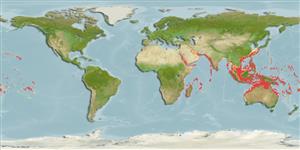Environment: milieu / climate zone / depth range / distribution range
Ökologie
seewasser riff-verbunden; tiefenbereich 3 - 150 m (Ref. 9824). Tropical; 32°N - 32°S, 26°E - 138°W
Indo-Pacific: throughout the Indian Ocean, including the Red Sea and the Persian Gulf to Hawaiian, Marquesas, and Society islands, north to southern Japan, south to Lord Howe Island. Record from the eastern Mediterranean incorrect (Ref. 9824).
Size / Gewicht / Alter
Maturity: Lm ? range ? - ? cm
Max length : 39.0 cm TL Männchen/unbestimmt; (Ref. 9710); common length : 20.0 cm TL Männchen/unbestimmt; (Ref. 3322)
Rückenflossenstacheln (insgesamt) : 0; Rückenflossenweichstrahlen (insgesamt) : 84 - 97; Afterflossenstacheln: 0; Afterflossenweichstrahlen: 61 - 73. Eyed side with dark spots, blotches and rings on body and median fins; 1 distinct dark blotch on middle of straight section of lateral line; narrow dark crossbars on eyed side of pectorals (Ref. 4417). Pectoral rays 9-12 (eyed side) and 9-11 (blind side).
Inhabits sandy or silty sand, and muddy bottoms of inner reef flats and seaward reefs; juveniles frequently found in tide pools (Ref. 9824, 48637). Benthic (Ref. 58302). Feeds on benthic animals (Ref. 5213). Utilized as a food fish (Ref. 4537) and processed into fish meal (Ref. 9824).
Life cycle and mating behavior
Geschlechtsreife | Fortpflanzung | Ablaichen | Eier | Fecundity | Larven
Hensley, D.A., 1986. Bothidae. p. 854-863. In M.M. Smith and P.C. Heemstra (eds.) Smiths' sea fishes. Springer-Verlag, Berlin. (Ref. 4417)
IUCN Rote Liste Status (Ref. 130435: Version 2024-1)
Bedrohung für Menschen
Harmless
Nutzung durch Menschen
Fischereien: kommerziell
Tools
Zusatzinformationen
Download XML
Internet Quellen
Estimates based on models
Preferred temperature (Ref.
123201): 18.6 - 28.3, mean 25.1 °C (based on 608 cells).
Phylogenetic diversity index (Ref.
82804): PD
50 = 0.5000 [Uniqueness, from 0.5 = low to 2.0 = high].
Bayesian length-weight: a=0.00891 (0.00474 - 0.01676), b=3.11 (2.95 - 3.27), in cm total length, based on LWR estimates for this species & Genus-body shape (Ref.
93245).
Trophic level (Ref.
69278): 3.5 ±0.37 se; based on food items.
Widerstandsfähigkeit (Ref.
120179): niedrig, Verdopplung der Population dauert 4,5 - 14 Jahre. (Preliminary K or Fecundity.).
Prior r = 0.25, 95% CL = 0.17 - 0.38, Based on 1 data-limited stock assessment.
Fishing Vulnerability (Ref.
59153): Low to moderate vulnerability (29 of 100).
Climate Vulnerability (Ref.
125649): Moderate vulnerability (44 of 100).
Nutrients (Ref.
124155): Calcium = 40 [16, 81] mg/100g; Iron = 0.462 [0.219, 0.857] mg/100g; Protein = 18.1 [16.6, 19.6] %; Omega3 = 0.0809 [, ] g/100g; Selenium = 41.3 [21.5, 84.8] μg/100g; VitaminA = 63.4 [16.2, 259.7] μg/100g; Zinc = 0.993 [0.659, 1.434] mg/100g (wet weight);
